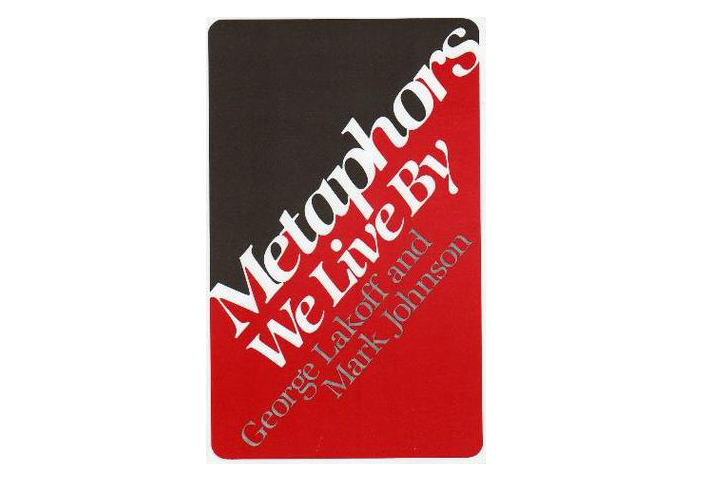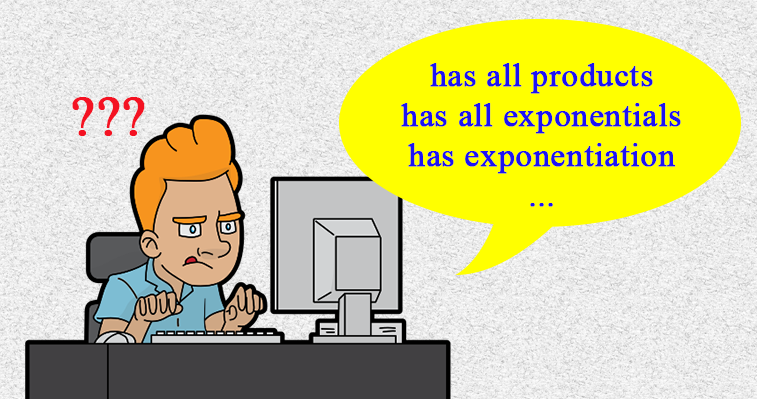Idioms and slangs are an important part of human language. They are short, expressive, and vividly reflect regional/historical mind-sets. And they are usually fun to learn! For example, I was rather amused by the English phrase rain cats and dogs in elementary school; and I’ve also found the Cantonese name for elephants 大笨象 ‘big silly elephant’ adorable.

Source: Pixabay, created by OpenClipart-Vectors and andremsantana
What’s wrong with idioms?
There are also idioms in category theory, and it’s super helpful for beginners to realize this from day one. I had tried following textbooks line by line and word by word, but there were always a few recurring phrases that I found hard to understand or even parse, as if they were not written in grammatically felicitous English. Since mathematicians used them all the time and hardly any textbooks included them in their terminology lists, my linguistician’s nerve told me they must be somewhat idiomatic within the field.
The difficulty with idiomatic terms, just like that with everyday idioms, is that they can’t be understood literally (i.e., compositionally). For example, rain cats and dogs doesn’t mean cats and dogs are really falling from the sky, and Cantonese speakers surely don’t really think elephants are silly. These are just metaphors instead, which are an important facet of human language and cognition.

Due to their unpredictable meanings, idioms require extra efforts in language acquisition. Sadly, unlike language textbooks, mathematical textbooks rarely specify which phrases are idiomatic, let alone explicitly explain their meanings. This is not ideal, because it means that readers can only grasp idiomatic terms through experience, which total beginners don’t have any.
What’s worse, a large number of math learners aren’t native speakers of English, who might have difficulty in understanding even everyday English idioms, let alone scholarly ones. Therefore, I generally object to the coinage or standardization of idiomatic terms in academic contexts, especially when the relevant phrases can also be understood literally (that is, falsely).
To avoid unnecessary linguistic barriers, academic terms should be maximally compositional.
Two categorical idioms
Nevertheless, since all human knowledge—including mathematics—must be recorded and passed on in human tongues, convention frequently overpowers rationality in verbal communication. This is just part of human nature. Since we can hardly do anything about it, we’d better be more sensitive and learn idioms in the idiomatic way; namely, by rote. In particular, I’ve found the following two idiomatic expressions useful to know at the beginning stage of category theory learning.
1. up to (unique) isomorphism
This phrase actually involves two closely related expressions: up to isomorphism and up to unique isomorphism. When I first met it I had already learned what an isomorphism was; I also knew what up to meant in everyday English. But I couldn’t figure out what the combination was supposed to mean. Tai-Danae Bradley similarly “complains” in her blog post that “‘[u]p to isomorphism’ is a phrase that seems to get thrown around a lot without ever being explained.”
As a linguistician, when I see a word or phrase I don’t understand, the first thing I do is turn to dictionaries. So, Merriam-Webster lists two definitions for the phrasal preposition up to:
(1) used as a function word to indicate extension as far as a specified place
e.g., sank up to his knees in the mud
(2) used as a function word to indicate a limit or boundary
e.g., up to 50,000 copies a month, worked up to the last minute
However, neither dictionary definition fits in the mathematical phrase in any self-evident way. Isomorphism surely isn’t “a specified place” like knees, but nor does it sound like “a limit or boundary.” So, there must be something left implicit—that is, hidden behind the words—by the inventor of the phrase.
As it turns out, the phrase actually means “as far as isomorphism allows” or “by way of isomorphism.” It’s usually used to modify propositions of the pattern
- X and Y are the same up to isomorphism,
which means that X and Y aren’t exactly the same but can be taken as the same in category theory because they are isomorphic. In other words, up to isomorphism is an adverbial specifying a condition under which the proposition is true. So, the above pattern can be paraphrased as X and Y, being isomorphic, are the same if we treat isomorphic constructs as the same. In category theory two constructs that are isomorphic behave identically in whatever way that matters to the theory. In Bradley’s words:
[W]e say two groups (or any other algebraic structures) are the same “up to isomorphism” if they’re isomorphic! In other words, they share the exact same structure and therefore they are essentially indistinguishable. Hence we consider them to be one and the same!
Sometimes the phrase is also used in the pattern X is unique up to isomorphism, which, following our above explication, simply means “X is unique if we view isomorphic constructs as one and the same.” Goldblatt has an illuminating explanation in Topoi:
Within any mathematical theory, isomorphic objects are indistinguishable in terms of that theory. … An object will be said to be “unique up to isomorphism” in possession of a particular attribute if the only other objects possessing that attribute are isomorphic to it. A concept will be “defined up to isomorphism” if its description specifies a particular entity, not uniquely, but only uniquely up to isomorphism. (p. 42)
In sum, the idiom up to isomorphism essentially reflects the externally oriented approach pursued in category theory, whereby a construct can be completely defined and identified by how it interacts with other constructs, without reference to its internal makeup (which in turn can be ignored when comparing constructs).
After the above discussion, now the meaning of up to unique isomorphism should also be clear—it simply means that the isomorphism in question is unique; namely, there’s only one isomorphism. So, whenever the textbook says up to unique isomorphism we can replace it by up to isomorphism (but not vice versa!), because the condition for the proposition the adverbial modifies is merely an isomorphism.
The phrase up to unique isomorphism is usually used in propositions related to universal properties or universal constructions. For example, a terminal object in any category, if it exists, is unique up to unique isomorphism. A terminal object by definition is an object to which there’s a unique arrow from any object in the same category, like this (I have highlighted the terminal object in red and omitted all irrelevant arrows):

This means that if there are two terminal objects in the category, the diagram should look like this:

In particular, there are a pair of back-and-forth arrows between the two red-colored terminal objects, which together define two composite loop arrows $!g\circ!f$ and $!f\circ!g$. However, since there is exactly one arrow to a terminal object from any object, including the terminal object itself, we must have $!g\circ!f=id_1$ and $!f\circ!g=id_2$; that is, $!f$ and $!g$ form an isomorphism. Hence, the two red objects are indistinguishable from a category-theoretic perspective, and for the category in question its terminal object is “unique up to unique isomorphism.”
2. have (all) products/coproducts/exponentials
The second categorical idiom that I’ve found useful to know as a beginner is have (all), where all is optional, as in the category $\mathbb{C}$ has (all) products and the category $\mathbb{D}$ has (all) exponentials. For example, Awodey (2010) defines a cartesian closed category as follows:
A category is called cartesian closed, if it has all finite products and exponentials. (Category Theory, p. 122)
Similarly, Goldblatt defines an elementary topos as follows:
An elementary topos is a category $\mathbb{C}$ such that (1) $\mathbb{C}$ is finitely complete, (2) $\mathbb{C}$ is finitely co-complete, (3) $\mathbb{C}$ has exponentiation, (4) $\mathbb{C}$ has a subobject classifier. (Topoi, p. 84)
But what do “has all finite products and exponentials” and “has exponentiation” mean? I don’t think I’ve ever seen the verb have and the quantifier all being used together like this in everyday English. I mean, I’ve seen expressions like have all the luck and have all the cards, but all always precedes a definite noun phrase the NP. And Goldblatt’s “has exponentiation” is even worse. It sounds terribly like an existential quantification (i.e., “there exists exponentiation in the category”) when it’s actually synonymous with Awodey’s apparently universal quantification “has all … exponentials.”
After being exposed to category theory for some time, I finally realized that the phrase have (all) X really means “X exists for all objects or suitable object combinations in a category.” Thus, Awodey’s definition of a cartesian closed category really says “a category is called cartesian closed if for any pair of objects in it there exists a product object and an exponential object based on them in the category.” And the third condition in Goldblatt’s definition of an elementary topos really says “for any pair of objects in $\mathbb{C}$ there exists an exponential object based on them in $\mathbb{C}$.”
In other words, in have all X the quantifier all doesn’t modify X at all but modifies an implicit, separate noun phrase “(pairs of) objects in the category.” But how are inexperienced pupils, especially those without expert guidance, supposed to know this?! 😵

Takeaway
- There are idiomatic terms in category theory, some of which are important.
- The phrase up to (unique) isomorphism means “by way of isomorphism” or “if we view isomorphic constructs as the same.”
- The phrase have (all) X means “X exists for all (pairs/tuples of) objects in the category.”
- Since idiomatic terms are beginner- and foreigner-unfriendly, they should either be accompanied by nonidiomatic explanations or better avoided in formal definitions.



Leave a comment